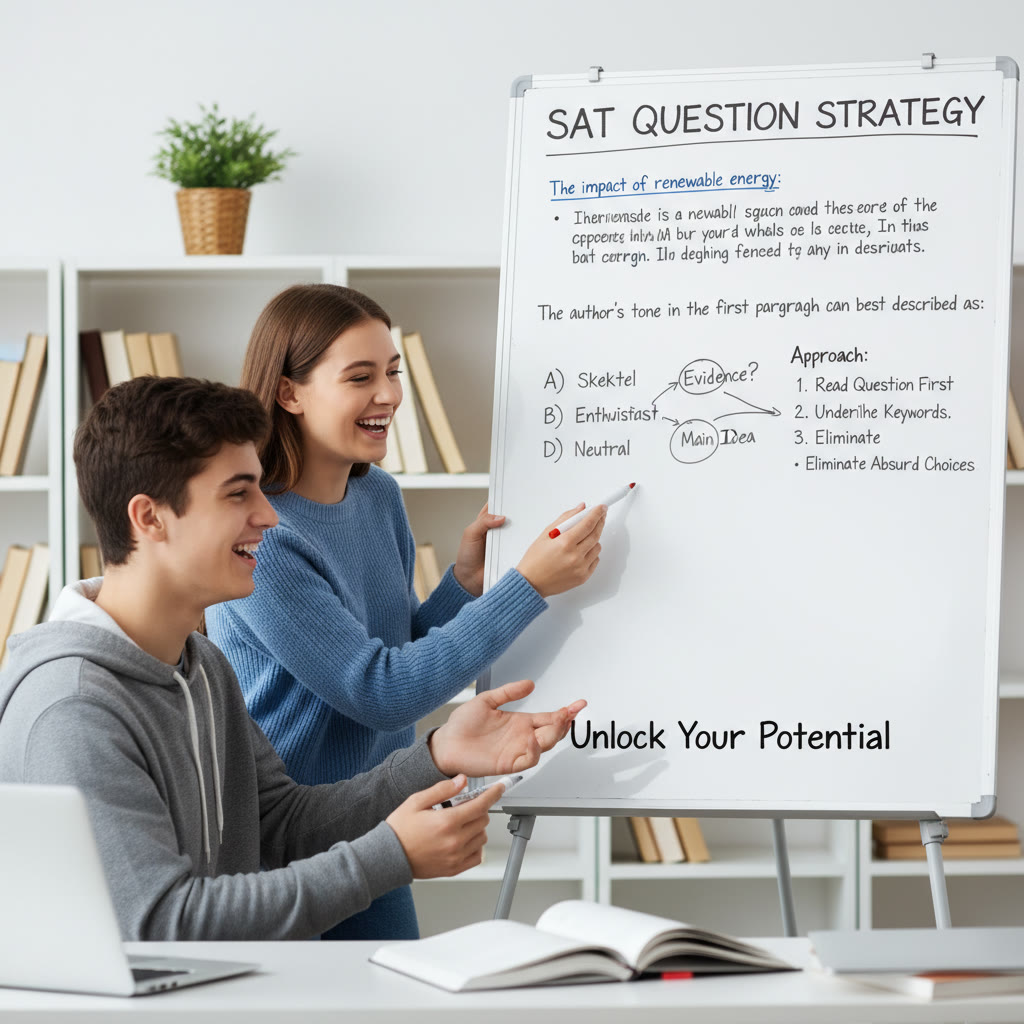The Most Common Mistakes Students Make in SAT Practice
Studying for the SAT feels like preparing for a marathon while someone keeps moving the finish line. You want to improve—fast—but it’s easy to end up spinning your wheels. Over the years of working with students and watching practice logs, I see the same pitfalls again and again. This blog walks through those mistakes in a friendly, realistic way and gives concrete fixes you can apply immediately. No fluff, just clear steps, examples, and a few real-world comparisons to make concepts stick.
Why understanding mistakes matters more than endless practice
Not all practice is created equal. Repeating the same flawed approach won’t help; it just produces more of the same results. Think of practice like a doctor’s prescription—if you don’t diagnose the problem first, your treatment will be ineffective. The same is true for SAT prep: identify the error patterns, then target them.
Mistake 1: Treating Every Practice Session Like a Score Race
Many students obsess over the number at the top of a practice test. High score today equals progress, right? Not always. Speed and scores are useful data, but they don’t diagnose why you missed questions.
- Why it happens: Pressure to see improvement fast; comparing yourself to peers; treating practice tests as performance instead of learning tools.
- What goes wrong: You repeat the same mistakes in later tests, think your strategy is working because scores fluctuate, or burn out by trying to chase small gains.
Fix: Treat practice tests as diagnostics. After each test, spend time analyzing wrong answers. Categorize mistakes by type (timing, concept, misread) and frequency. A single test should produce an action plan: 30 minutes reviewing algebra errors, one focused reading comprehension drill, etc. Over time, this targeted approach compounds much better than blind repetition.
Mistake 2: Ignoring Timing Until It’s Too Late
Timing on the SAT is a skill, not a random trial. Students either rush through to finish or leave questions blank to save time for others. Both extremes can cost you points.
- Why it happens: Unfamiliarity with section pacing; underestimating reading time; overconfidence in speedy problem solving.
- What goes wrong: Running out of time on the last passage, guessing wildly on multiple questions, or mismanaging breaks between sections.
Fixes and drills:
- Practice sections with strict timing and log where you slow down (question types, passages, algebra vs. geometry).
- Learn pacing benchmarks—the average time per question and time to allocate per passage or problem set. Use a watch or an app to get comfortable with those beats.
- Practice triage: mark questions that are taking too long, move on, and come back if time allows. This skill becomes automatic only with deliberate practice.
Quick example: smart pacing in the Reading section
For a typical 5-passage SAT Reading section, try a pacing goal: 13–15 minutes per paired passage set (if there are paired passages) and 10–12 minutes for single passages with simpler question sets. If you see a dense science passage, spend slightly more time on comprehension and slightly less on trap answers—balance matters.
Mistake 3: Doing a Thousand Questions Without Learning From Mistakes
Quantity beats quality only if you learn from each repetition. Doing many practice questions but not reviewing why you missed them is like reading a foreign language book without looking up words you don’t know.
- Why it happens: Students get addicted to ticking off questions for motivation; review feels slower and less fun.
- What goes wrong: You memorize wrong approaches, keep missing the same type of question, and plateau.
Fix: Build an error log. For each missed question record:
- Question type (e.g., main idea, function, algebra, systems)
- Why you missed it (careless, concept gap, timing, misread)
- Correct reasoning summarized in one sentence
- One practice item to reinforce the lesson
Over time the log becomes a personalized syllabus. If you see 30% of mistakes are from comma rules in grammar, you know where to focus.
Mistake 4: Over-Reliance on Shortcuts and Tricks
Shortcuts are tempting. They make you feel clever and can be helpful in certain contexts. But if they replace deep understanding, you’ll hit trouble on tricky twists the test sometimes throws at you.
- Why it happens: Shortcuts give quick wins and feel satisfying; test-prep culture often glorifies tricks.
- What goes wrong: When question frameworks shift slightly, the trick fails and you lack the conceptual backup to solve the problem.
Fix: Learn both the shortcut and the principle behind it. For example, know the formal rules for parallel structure or the algebra behind function transformations. Use shortcuts to save time once you can confirm the principle quickly in your head.
Mistake 5: Neglecting Official Practice Tests
People swarm to question banks, apps, and third-party collections. Those can be useful, but nothing replicates the wording, structure, and realistic difficulty of official College Board tests.
- Why it happens: Convenience of apps, volume of third-party content, desire for variety.
- What goes wrong: Students get comfortable with the wrong phrasing and question structure or become miscalibrated on difficulty.
Fix: Make official College Board practice tests the backbone of your prep. Use other resources for targeted drills, but validate your progress with timed, full-length official tests periodically. Treat these official tests as the gold standard for pacing, stamina, and question style.
Mistake 6: Skipping Foundations for Speed
Speed without accuracy is useless. Students who rush into advanced practice without mastering core skills—algebraic manipulation, grammar basics, or active reading strategies—hit a wall.
- Why it happens: The desire to jump to practice tests quickly; impatience with boring fundamentals.
- What goes wrong: Errors on questions that assume basic concepts are automatic, like distributing negative signs or recognizing subject-verb agreement.
Fix: Spend dedicated time on fundamentals early. A short investment—weeks, not months—pay huge dividends. Build a mini-syllabus: algebra fundamentals, grammar essentials, active reading techniques. Once those are reasonably solid, your accuracy will improve and speed will follow.
Mistake 7: Not Simulating Test Conditions
Full-length practice under real conditions is an underrated and powerful tool. The SAT is as much about stamina and focus as it is about content knowledge.
- Why it happens: Tests are long and intimidating; practice in short bursts feels easier.
- What goes wrong: Students struggle with fatigue, misjudge their true pacing, or forget logistical details on test day.
Fix: Take at least a few full-length, timed tests under quiet, distraction-free conditions. Practice breaks just as on test day, use the same type of calculator, and eat the same kind of breakfast to learn what your body and brain need to perform.
Data Snapshot: Typical Score Improvements vs. Targeted Study Hours
Here’s a realistic snapshot of how score improvements often map to disciplined, targeted practice. These are generalized estimates—individual results vary based on starting level and study quality.
| Focused Study Hours (over 8–12 weeks) | Typical Score Gain (Evidence-Based Reading & Writing + Math) | Main Driver |
|---|---|---|
| 20–40 hours | 30–80 points | Focused review of fundamentals and some timed sections |
| 40–80 hours | 80–160 points | Consistent practice tests, error logs, targeted concept work |
| 80+ hours | 150–250+ points | Personalized tutoring, adaptive practice, staged test simulations |
Why this table matters: time alone isn’t enough—how you use those hours determines whether you land in the lower or higher end of the range. Targeted practice and error analysis are key multipliers.
Mistake 8: Treating All Weaknesses the Same
Weaknesses have different causes. If you’re missing reading questions because you skip passages, that is different from missing them because you don’t understand the passage vocabulary.
- Why it happens: Students lump mistakes into a single “I’m bad at reading” category instead of diagnosing sub-skills.
- What goes wrong: Study time is wasted on irrelevant materials; improvement stalls.
Fix: Break skills down. For Reading, track issues like vocabulary in context, inference, evidence support, and main idea. For Math, separate algebraic manipulation, geometry, and word problems. Then build short drills tailored to each sub-skill.
Mistake 9: Cramming Instead of Building a Sustainable Routine
All-night cram sessions feel dramatic but are rarely effective for a concept-heavy test like the SAT. You remember facts for a little while, but true mastery needs spaced repetition and rest.
- Why it happens: Time constraints; procrastination; thinking of SAT prep as a sprint.
- What goes wrong: Knowledge is shallow and fragile, mistakes rebound on test day from fatigue and stress.
Fix: Create a sustainable schedule: short (30–90 minute) sessions several times a week, with a weekly full-length test or long section. Use spaced repetition for vocabulary and formulas. Remember that sleep and nutrition are part of a study plan—your brain consolidates learning while you rest.
Mistake 10: Going It Alone Without Adaptive Feedback
Self-study can be powerful, but when you plateau, personalized feedback can unlock the next level. This doesn’t mean you need to hire someone immediately; it means know when to ask for help that targets your specific needs.
- Why it happens: Pride, budget limits, or not recognizing the value of targeted help.
- What goes wrong: Small misconceptions persist, inefficient study habits continue, and progress stalls.
Fix: Consider a short period of personalized tutoring or coaching when you hit a plateau. One-on-one guidance helps identify subtle patterns—like consistent misinterpretation of negatives in word problems, or a tendency to pick trap answer choices in reading. Services that combine expert tutors with AI-driven insights can be especially efficient: they highlight recurring mistakes and suggest tailored practice. For students who want that blend of human coaching and smart data-driven planning, Sparkl’s personalized tutoring offers 1-on-1 guidance, tailored study plans, expert tutors, and AI-driven insights that translate your practice into a clear improvement roadmap.
An example of adaptive help
Imagine a student who misses many questions caused by misreading qualifying words (only, except, not). A tutor can create micro-lessons to practice those traps; an AI tool can scan weeks of tests to show how often that error appears and recommend drills. Together, they close the gap faster than either tool alone.
Putting It Together: A Simple 8-Week Plan to Avoid Common Traps
This plan assumes a busy student who can commit 6–8 hours per week. Modify up or down depending on your schedule.
- Week 1–2: Diagnostic. Take a full official practice test. Build an error log and a fundamentals checklist.
- Week 3–4: Foundations + Timing. Focus on fundamentals that your log highlighted. Do timed sections twice weekly.
- Week 5–6: Targeted Drills. Use error log to focus on the top 3 weaknesses. Begin full-length test every other week.
- Week 7: Simulation. Two full-length timed tests under test conditions, review deeply after each.
- Week 8: Polishing. Short drills, review notes from your error log, light practice to keep sharp and rested before test day.
Pair this schedule with at least one session of personalized review—whether with a teacher, counselor, or a tutor who can point out persistent patterns. That’s where smart tutors (and AI-driven insights) transform effort into consistent improvement.
Final Thoughts: Small Changes, Big Gains
The path to a better SAT score is rarely dramatic. Most students improve by making small, intentional adjustments: reviewing errors properly, pacing smarter, fortifying weak fundamentals, and using practice strategically. It’s the compounding effect of a few disciplined habits over weeks that produces the big gains.

If you’re feeling stuck, consider adding short, personalized tutoring sessions to your plan. Strategic, one-on-one guidance—combined with clear error logs and targeted practice—can accelerate improvement and help you avoid the most common traps. Sparkl’s tutoring model, which pairs expert tutors with AI-driven insights and tailored study plans, is a natural fit for students who want direction without wasting time on ineffective drills.

Keep this list handy as you study. When practice is structured and reflective, it stops being a source of anxiety and becomes a reliable bridge to the score you want. You don’t need perfection overnight—just a steady, smarter approach. Good luck, and study with intention.















No Comments
Leave a comment Cancel